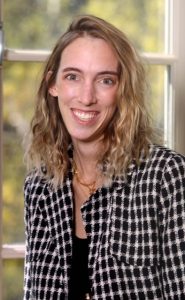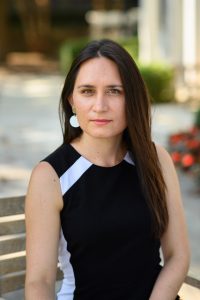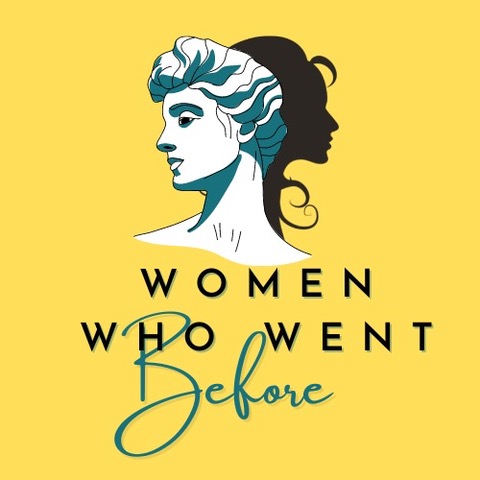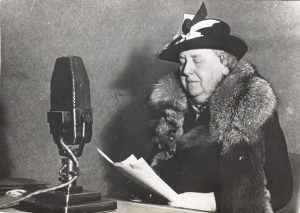Talking About Women’s History: Three Questions and an Answer with the Hosts of Women Who Went Before
Rebekah Haigh and Emily Chesley host and produce Women Who Went Before, a gynocentric podcast on the ancient world. Both are PhD candidates at Princeton University. Rebekah specializes in Religions of Mediterranean Antiquity and is writing a dissertation that explores gendered piety and violence in the Dead Sea Scrolls and ancient Judaism. Emily researches late antique history, and her dissertation examines women in the eastern Roman Empire amidst the military and religious upheavals of the 5th–8th centuries CE.
Take it away, ladies!
- Rebekah Haigh
- Emily Chesley
Photocredit: Sameer Khan/Fotobuddy, LLC.
What inspired you to start the podcast?
Rebekah: We certainly didn’t set out to start a podcast! It all began as a Covid project. In spring 2020 Emily and I had a conversation about why neither of us had spent much time thinking about women and gender in the ancient world. We realized it was a huge gap in our preparedness to be scholars, but there was a pandemic happening and there were no classes or library access. Then we thought “since, we’re stuck at home … let’s try starting a reading group.”
We weren’t reading around specific historical women or texts about them. We were doing a lot of theory work work: looking at different waves of feminism and how they intersected with scholarship. It wet our appetite because when you do that kind of theory work, you’re always trying to find connections like, “Okay, could I apply it to women that I’m familiar with? The historical texts I’m familiar with? I kind of want to try it.”
Emily: As it happened, it ended up being pretty popular. People joined from beyond Princeton, from different universities and even multiple countries. We realized that we weren’t the only ones who felt there was a gap in our education! And that shared enthusiasm fanned the flame.
Even people who weren’t enrolled in graduate programs heard about our group through social media and their friends, and they reached out. Ultimately their interest made us realize that this topic wasn’t just of interest to people in the Academy; there is a hunger across society from people eager to learn about women in the ancient world. And then a conversation Rebekah had got us thinking towards a bigger picture.
Rebekah: At the end of that year, an administrator and mentor suggested turning our reading group into something more substantial, something that would reach that wider audience. As we brainstormed public scholarship formats, we assumed there were already a bunch of historical podcasts about ancient women. But while there were loads of podcasts on history, even ancient history, we couldn’t find anything on ancient women. Medieval women, women in 19th century America, but nothing about women in the ancient world. So we decided to make a podcast.
Emily: It’s been a really rewarding journey so far! Our first season just finished, and we’re in preproduction for season two which will release in the fall.
Rebekah: And one of the first interviews we recorded for the podcast, with Solange Ashby on the warrior queens of Meroe, was someone who had participated in the original reading group!
What work of women’s history have you read lately that you loved? (Or for that matter, what work of women’s history have you loved in any format? )
Rebekah: Well, the answer that jumps to mind is going to reveal a lot about me and how I first came to love history – and also a lot about Emily. Both Emily and I have this shared experience of being home schooled with the same curriculum, one of the things we initially bonded over. We even read the same cluster of historical novels about women. One of which was Mara, Daughter of the Nile, a book that I’ve always credited for my early interest in ancient history. The novel was about this young girl who lived in Egypt. She’s not a real person. But the book gave me a taste of what it might be like to live in the ancient world and I wanted to know more.
Emily: Historical fiction can powerfully engage you, whetting your appetite for “thicker” history books. Rebekah and I definitely shared a love rooted in a childhood of reading about women in history, whether real or fictional.
As far as books today, I have to caveat that as a grad student, I don’t read as much pure history outside of work. I find I have to take a mental break and separate out the other kinds of reading from the work-reading (which yes, I also enjoy; and if you check the source lists for our episodes you’ll find many of my go-to academic texts on women’s history). I love to read for pleasure, but it’s usually fiction of some kind, whether YA or Dorothy Sayers or something in between.
Rebekah: Yes, exactly. I don’t read much nonfiction beyond my own research. In my spare time, I want a break from heavier stuff, so I will usually read fictional stuff or sci-fi but not a lot of biographies of women.
Emily: One book both Rebekah and I read, which isn’t a history of the past so much but in a way is a history of our present, is Living A Feminist Life by Sara Ahmed. She does a wonderful job of linking academic work on feminist theory with lived women’s experiences in a practical way. She applies insights from feminist scholars to help women, especially women of color and queer women, understand their own day-to-day lives and the resistance they receive from the world. One of Ahmed’s famous ideas that recurs throughout her corpus is that when you point out a problem you become the problem, and it’s helped encourage me in moments advocating for gender equality in the workplace.
In terms of more traditional histories about women and still grippingly written, I loved Code Girls by Liza Mundy, and The Radium Girls and The Woman They Could Not Silence by Kate Moore. The latter is particularly moving; it’s about Elizabeth Packard, a 19th-century woman from Illinois whose husband institutionalized her, and it looks at the laws in that century that basically gave husbands complete control over their wives. Julia Cooke’s Come Fly the World is a history of the first jet-set stewardesses for Pan Am. I admit I was first intrigued by the topic (speaking of women’s history in other formats) because in college my roommates and I watched the short-lived TV series Pan Am, crowding onto our old couch every week and obsessed with the glamor of it all. Then reading this archival history, you can’t help but be struck by the indignities and sexism these women endured while breaking the glass ceiling and their fortitude in the first decades of commercial air flight.
This is in some ways an atypical women’s history book because she is still alive today, but Nell Painter’s memoir Old In Art School also stands out. She’s an award-winning historian of African American history and race, and one of her most famous books was The History of White People. Then after she retired, she went to art school and started working as an artist. Her memoir describes that journey, exploring the links and tensions between her academic work and her art practice, and mulling on her experiences as an older black woman in the predominantly white and younger art world.
Rebekah: I can add a nonfiction book which I have managed to get halfway through, The Way of Perfection by Teresa of Ávila. The book is not a biography or a historical piece but rather personal reflections by a Spanish nun and mystic who lived in the 16th century. She was pretty radical for her time. Teresa led a monastic reform that made many people unhappy with her, but her writings have endured the test of time. The Way of Perfection is a book about prayer and meditation, how to be intentional about your spiritual life. Though written hundreds of years ago, it remains an insightful piece on practices of meditation, a topic that I’ve been interested in for a long time.
I think one of the reasons that her personal reflections, and works like it, still speak to everyday people is because in them we have access to women’s inner thoughts and feelings, something we don’t usually have with the ancient world. There is a degree to which when we have access to what women are writing and what they’re thinking, it’s easier for contemporary history aficionados to identify with those figures and to find space for themselves and their stories.
What was the most surprising thing you’ve found doing historical research for your work?
Emily: Honestly, I think for me the most surprising thing was realizing just how much we actually know about ancient women, just how much research there actually is. Embarrassingly, I hadn’t read extensive scholarship on women’s history during college and graduate school because it wasn’t part of the core curriculum. I didn’t know all that was there until I began looking intentionally.
My introduction must have been in my final semester of seminary, when I took an elective on women in contemporary African Christianity and audited another class on medieval women, and those started to crack open the doors. Then, once your foot is in and you find, say, one article with robust footnotes, you can start following the trails. There are so many dedicated scholars unearthing stories and clues about pre-modern women through innovative detective work. The trails are rich and never-ending, and we’ve gotten to explore some for our podcast. I suppose that becomes the lesson –which, come to think of it, also applies to other areas of life– you have to choose to look.
Rebekah: Piggybacking on that, as an academic I find myself reading for things that I’m interested in, that intersect with my research on violence and ritual. If you’re not looking for women, it’s easy to overlook them. But, once I started thinking about questions of gender, especially once Emily and I had started the podcast, I started looking. Now as I’m doing my research, if I see a reference about a woman performing a ritual, I’m going to jot that down and go read about it. Because now that I am paying attention to women, I’m seeing texts and scholarship all over the place, usually in the footnotes. The surprising thing is that there are a lot more women than I thought there were.
It’s my sense, both from my students and also my own college experience, that learning about women in history is often regulated to a gender studies or topical class on women. You might get a course about women and magic, or women and sexuality. Or, perhaps women will appear as a topic for one week on a syllabus, or there might be a reading or two dedicated to them in a course otherwise dominated by historical men. I think we need to move beyond this tendency in academia to check boxes when it comes to teaching about ancient women or to limit student interest in women to certificate programs. Stop putting women in the footnotes.
Something one of our earliest podcast guests said has stuck with me, which is this concept of above and below the line in academic writing. Above the line is what’s written in the body of your paper, article, or book. This tends to be your thoughts and the thoughts of those you perceive to be the big name scholars – the people whose work you know really well. Everybody else goes below the line, in the footnotes. These conventions about which scholars “really matter” create a self-perpetuating cycle, so that other scholars (often women) keep getting relegated to the footnotes. This concept of above and below the line is really helpful for thinking about where we need to go with women’s history and research about women. There’s so much great work being done about women in the ancient world, but it often goes overlooked. It’s still “under the line” in some sense. So it is not enough to start paying attention to women, we need to actively put them above the line. Which is what Emily and I try to do in our podcast, Women Who Went Before. We’re taking all this amazing research and making it more accessible to people who might not be hanging out in academic libraries trying to write a dissertation.
Emily: Or who lack a subscription to JSTOR! Many people might not have access to academic journals or research libraries, but they definitely are interested in learning about history and its women. That’s where podcasts, blogs like yours, radio programs, TV series, historical fiction, video games, and more creative public scholarship come into play. And I’ll add lastly, it’s not just what scholars say and where, but also how we say it. To truly be accessible we need to communicate academic research and writing in emotive and engaging ways.
A question from Rebekah and Emily: What historical woman would you want to go back in time and meet, and how would you spend the day with her?
My first thought on reading this question was: So many women! How can I possibly choose?
My second thought was: Queen Wilhelmina of the Netherlands. Wilhelmina ascended the Dutch throne in 1898 at the age of 18. She was sixty when Nazi Germany attacked the Netherlands. She transformed herself from a stiff, shy, distant ruler to the heart of her country’s resistance. Hours after the German attack began, she made her first broadcast against the Nazis on Dutch radio. She made her next broadcast the day after she arrived in Britain. Every day thereafter, the the queen spoke to her people at the start of the Radio orange program broadcast to the Netherlands by the BBC. Her radio speeches were passionate and personal; with one exception, she wrote them herself. The Dutch joked that the queen’s grandchildren weren’t allowed to listen to her broadcasts from their refuge in Canada because she used such foul language when she talked about the Nazis.
As far as what we’d do: given my current project I’m in the mood to kick back and trash talk the Nazis over a dark beer.
Want to know more about Women Who Went Before?
Listen to the podcast: https://womenwhowentbefore.com/
Follow them on Twitter: https://twitter.com/womenbefore
Check out the podcast Facebook page: https://www.facebook.com/womenbefore
***
Come back tomorrow for two questions and an answer with biographer Eleanor Fitzsimons








